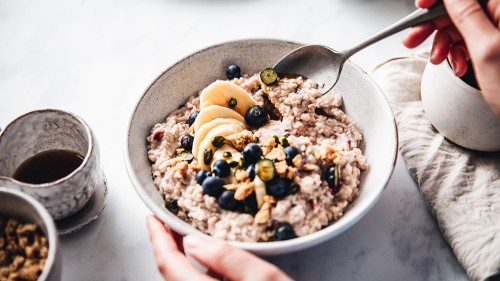WellnessVerge is reader-supported. We may earn a commission when you make a purchase through the links on this page. Learn more about our process here.
WeightWatchers Diet Review: A Dietitian’s Objective Analysis
Last Updated on October 11, 2021
Medically Reviewed by Ana Reisdorf, MS, RD
As a registered dietitian and weight loss expert, I would recommend Weight Watchers as a healthy, flexible, and more balanced approach to weight loss.


|
Pros
|
Cons
|
How WeightWatchers Diet Works
WeightWatchers, also known as WW, is a membership program that promotes weight loss and an overall healthy lifestyle.
It is probably one of the most well-known and popular weight loss programs, including being promoted by celebrities like Oprah Winfrey.
WW has changed significantly over the years, moving away from being solely a weight-focused program to promoting overall health.
The WW membership is flexible, and you cancel your monthly plan at any time.
The WW program is designed to help you build healthy habits and learn a balanced way of eating for life in the following ways:
WW SmartPoints System
WW works by assigning a certain number of “SmartPoints” to each food. The point value is based on the food’s overall nutritional value as a way to teach balance.
Compared to previous years, WW’s guidelines have changed significantly to allow more flexibility, options, and balance in their meals to promote a gradual weight loss of 1–2 pounds per week.
Your total daily points allowed are dependent on your individual needs and the specific plan you select.
Depending on your plan, you are allowed an unlimited amount of certain “ZeroPoint” foods thought of as “free” foods.
In general, foods higher in calories from refined carbs, sugar, or fat are higher in points, and fruits, vegetables, and lean proteins are lower.
Alcohol is also high on the list for a high point value.
WW Freestyle Program
Traditionally, WW was only about not going over your total points. Now, they offer more options and flexibility with their new “WW Freestyle” program.
This program includes over 200 foods considered ZeroPoint, which means they do not count towards your daily SmartPoints allotment.
These “free foods” are nutritious foods like fruits and vegetables and lean proteins like boneless, skinless chicken breast. This encourages you to eat more of these types of foods for weight loss.
WW Nutrition Plans
There are three nutrition plans you can choose from, depending on your preferences for the daily number of points and “free foods”:
Green
The Green plan offers the smallest list of ZeroPoint foods but the largest daily points budget. In addition, the ZeroPoint foods list is limited to fruits and non-starchy vegetables.
The Green plan is similar to the traditional WW plans before Freestyle was introduced.
If you don’t care about the number of ZeroPoint options but want more daily points for variety, this plan may work for you.
Blue
The Blue plan is considered the middle of the road program and is formerly known as the original freestyle program.
For ZeroPoint foods, you are allowed all the same fruits and vegetables as the Green plan, but they add on some other options:
- Starchy vegetables like corn and peas
- Skinless chicken and turkey breast
- Eggs
- Fish and shellfish
- Beans and legumes
- Nonfat plain yogurt
- Vegan proteins such as tofu and tempeh
If you choose this plan, you’ll have the ability to incorporate more ZeroPoint foods into your plan for variety, but you’ll also have a moderate daily points budget to use on other foods.
Purple
The Purple plan offers the most extensive list of ZeroPoint foods out of the three plan options but the smallest daily points budget.
For ZeroPoint foods, you are allowed all the same foods like the Green and Blue plans, with these additional options:
- Potatoes
- Whole wheat pasta
- Veggie pasta such as chickpea or red lentil
- Brown rice
- Oats
- Other grains like barley, quinoa, and farro
If you enjoy many of these ZeroPoint foods and don’t want to feel restricted, this plan may be the best for you.
With this plan, you have the smallest budget for other foods but can build your meals around all the zero points foods you love.
WW App and Additional Support
Support, education, and accountability are all core components of the WW program.
Most of this is provided via the WW app, which WW members use daily to track their points, learn healthy eating tips, and stay on course.
Some of the features you’ll find on the WW app are:
- Ability to track your daily SmartPoints budget and view your ZeroPoint food list. A barcode scanner is also available to scan your foods to use while tracking.
- Community support and live coaching anytime via the in-app social network, Connect. The WW coaches are not all qualified nutrition experts but are often WW members who have seen success with the diet program themself.
- FitPoints 2.0, which syncs with your fitness tracker and shares exercise advice and workout suggestions based on your goals.
- Healthy recipes, educational webinars, and blog articles to give you fresh ideas and keep you motivated.
Recently WW also launched a more robust program called WW+, which offers more personalized diet and exercise recommendations and accountability.
Here are some of the additional features for WW+:
- Access to meal planners based on what’s in your fridge
- Detailed progress reports and weekly check-ins
- 5-minute coaching for behavior-change techniques
- Personalized recipes
- Science-backed tips
- Meditation, exercise, and stretching guidance
While the WW system is not entirely perfect, it is similar to the type of diet I would recommend to clients for sustainable weight loss.
WW Diet’s Scorecard
The Weight Watchers program was objectively evaluated by a dietitian based on the following criteria:
| Evidence-Based | 5/5 |
| Easy to Follow | 3/5 |
| Customization | 5/5 |
| Sustainability | 5/5 |
| Accountability | 3/5 |
| Value for the Price | 4/5 |
| Safety | 4/5 |
| Overall Rating: | 4.1/5 |
Foods to Eat and Avoid
With WeightWatchers, you don’t have to avoid any foods completely. However, certain foods have to be limited, such as those high in overall calories, saturated fat, or sugar.
Here are some examples of high points foods to limit:
- Red meat
- Fried foods
- Bagels
- Cookies
- Cake
- Pastries
The WW system encourages you to use lower points or ZeroPoint foods to build your meals.
Here are foods that are encouraged and are generally lower in points:
- Lean proteins like skinless chicken breast or turkey
- Fish and shellfish
- Eggs
- Beans and legumes
- Nonfat plain yogurt
- Plant-based proteins like tofu and tempeh
- Fruits
- Vegetables
- Whole grains
You are allowed a certain number of points per day based on your weight, activity level, and overall plan.
Since WW incorporated their new freestyle program, it offers more flexibility in the diet with ZeroPoint foods.
Foods in the ZeroPoint category are essentially unlimited. Based on your plan, this may include fruits, vegetables, lean proteins, and whole grains in unlimited amounts.
While it may sound scary to allow yourself an unlimited quantity of food when trying to lose weight, there is some science behind this method.
These ZeroPoint foods are naturally healthy and filling so that you won’t feel deprived. Therefore, it is harder to overeat them.
On any long-term weight loss program, feeling full and satisfied is an essential component. (1)
Summary
No foods are completely off-limits on the WW program. Lean proteins, fruits, vegetables, and whole grains are encouraged as well as unlimited quantities of “free” foods.
Can It Help You Lose Weight?
WW is an effective diet for many when followed correctly. It is probably one of the most well-researched diet plans out there.
There are studies that show one-third of the participants on WW achieved greater than a 5% weight loss, which is considered clinically significant for health. (2)
There was also an extensive research review on several commercial diet programs, where WW was found to be one of the most effective long-term. (3)
Another 2017 study was done that directly compared those following WW to another general weight loss program. (4)
Those who followed the WW program for a year lost significantly more weight than the other group.
However, to maintain this weight loss, it’s necessary to continue following the diet and tracking your points.
It’s important to note many of these studies were funded by WW. However, the data collection and analysis were put together by an independent research team. This helps to reduce any potential bias.
There are several likely reasons for the success of many people on WW:
- It offers a balanced way of eating
- No foods are completely off-limits
- It teaches you how to eat healthy
- It provides accountability in the form of tracking, coaching, and a support network
The support and accountability are provided by WW coaches at various levels, depending on the plan you sign up for. Accountability is vital when it comes to successful long-term weight loss. (5)
It is a downside that many of the WW coaches are not registered dietitians or other certified nutrition experts. However, they still provide motivation and encouragement that can be helpful in moving towards your goals.
I had many clients successfully lose weight with WW when they were consistent with tracking. However, often if they stopped tracking, they would start to regain the weight back.
In general, WW does work, but it requires consistent effort for long-term weight loss success.
Summary
Based on several studies, WW is an effective weight loss program for those that engage with the app and follow the program’s guidelines.
Sustainability
Overall, WW is a sustainable plan because it allows flexibility in food choices and promotes balance.
With almost every client that I see, the most common reason they regain weight is that their diet plan was not sustainable. Either it was too restrictive, or there was not enough support provided.
On the other hand, some people may find it cumbersome to track points long-term. This may lead to slipping off the diet after some time if you lose the motivation to keep tracking.
If you’re someone who thrives on accountability and loves to track your meals, you will probably do well on the WW program and find it easy to stick to.
However, if you are short on time and find tracking overwhelming, it may be hard for you to follow WW long-term.
If followed correctly, WW is a diet you can stick to even when you are out at restaurants, parties, and traveling as long as you have the Weight Watchers app to track what you’re eating.
Summary
The WW program’s diet guidelines can fit easily into most people’s lives. However, those who dislike tracking their food may have more difficulty sustaining it unless they learn proper portions over time to eventually follow it on their own.
Accountability
Support and accountability are provided to WW members in various ways. There are three different membership options based on the amount of accountability you desire.
All of the accountability is provided via the WW app. As a WW member, you will have access to training, workshops, and health coaches.
You can also connect with other WW members to set goals together and keep each other motivated.
There are virtual and in-person weekly member support meetings, which is often the most popular part of the program.
Depending on how robust your plan is, you can have access to all of the group training or have a plan set up personally by a WW coach.
WW’s more robust program, the WW+, also provides more individualized guidance and accountability in a holistic way.
When it comes down to it, accountability is often what keeps you going even on the more challenging days.
You may often know what you need to do to lose weight, but nobody is holding you to it.
I’ve seen this with many clients that I work with long-term, where the accountability piece becomes the most critical factor in keeping the weight off.
Overall, the accountability provided in the WW program is consistent and can help you stay on track.
Summary
The WW program provides a lot of accountability via their app through support groups and health coaching at an affordable price.
Value for the Price
The cost for a Weight Watchers membership ranges from $3.38 to $6.92 per week:
-
Digital is the cheapest plan and is online only. This means you only get access to the website and accompanying smartphone app. For $3.38 a week, you also get access to online coaches and on-demand programs to keep you on track.
-
Digital 360 membership provides digital access plus coaching and “on-demand” wellness experiences. This program costs $4.61 per week.
-
Ultimate Workshop is the most expensive plan at $6.92 per week. This program includes all of the digital products and in-person meetings at your local WW center. There is also a virtual meeting option included with this plan.
All the plans include access to the extensive recipe database and weekly progress reports.
I feel this is a very reasonable price given the resources and level of support that is provided.
But, if you want long-term results, your best bet is to be a lifetime member and continue to invest in the program.
This cost can add up to be a lot over time as a lifetime member. But if it works, WW is well worth the investment in your health.
Summary
WW is a high-value program that offers accountability, engagement, education, and tools at an affordable price.
Safety
Based on the available research, WW is an overall safe plan to follow for most people, as it does not promote very restrictive eating.
It emphasizes various foods and food groups and promotes the importance of exercise, stress management, and behavior modification.
I would not recommend WW for anyone with a history of an eating disorder, as tracking points alone may trigger more eating disorder tendencies.
I would also not recommend it during pregnancy or in the first six months of breastfeeding when weight loss is generally not recommended.
Summary
The WW program is balanced and safe for most people but always check with your doctor before starting.
How WW Compares to Alternatives
Out of all the commercial weight-loss diets, WW is the one I’d most likely recommend to clients.
It does not require you to completely avoid any particular food or food groups and promotes a balanced diet and lifestyle.
Compared to most other weight-loss diets out there, WW is probably one of the most well-balanced and sustainable options.
The program most similar to WW is Noom, another app-based weight loss program. Similar to WW, Noom focuses on healthy lifestyle changes and provides accountability.
Noom’s diet program focuses more on tracking calories but doesn’t provide as much customization as WW does in terms of where those calories are coming from.
Still, there are three different food categories in Noom:
- Red: Sweets, high-fat meats like bacon, fats like coconut oil and olive oil, processed foods like pizza and french fries. Should be consumed sparingly.
- Yellow: Lean proteins like chicken, beef, and fish. Beans, quinoa, avocado, and olives. Should be consumed in moderation.
- Green: Fruits, vegetables, whole grains, and fat-free dairy products. Should be encouraged.
Like WW, Noom also has several research studies to back up its effectiveness.
One 2020 study was done on over 14,000 people. After one year, all those on the Noom program lost between 5–8% of their body weight. (6)
Those that were older or that were more engaged with the app experienced a greater weight loss.
Another large 2017 study compared women following Noom versus those trying to lose weight on their own. (7)
Those who followed Noom lost 5–8 lbs more after three months than those not using the program.
The most significant difference between Noom and WW may be the ability to sustain the program. Noom often recommends a more strict daily calorie limit that may be difficult to maintain.
As a weight loss expert, I do not recommend very-low-calorie diets for most people as they often lead to feelings of deprivation. This eventually results in overeating and weight regain. (8)
Both Noom and WW have great features and provide a lot of support. However, if I were to choose one, I would select WW because it doesn’t require you to count calories.
With either program, you’ll see the most significant results by fully engaging in the program that you choose.
Summary:
Compared to other weight loss programs, WW is a good choice for someone looking to improve their lifestyle habits and lose weight for good.
Frequently Asked Questions About WW
What is Weight Watchers?
Weight Watchers, or WW, is a weight loss program that utilizes a points system to guide you to healthier eating habits. You are assigned a daily number of total points and a certain unlimited number of “free” foods to help you lose weight.
What can I eat on WW?
No foods are off-limits on the WW program. However, more whole foods such as lean proteins, fruits, vegetables, and whole grains are encouraged, while processed foods are discouraged.
Who is WW for?
WW is for someone who doesn’t want a restrictive diet and is looking for a more balanced way of eating for life. It is for someone who wants to learn how to eat well and lose weight in a healthy way.
Who is WW not for?
The WW program is not for someone who has a history of an eating disorder, as tracking food can trigger disordered eating behaviors. It’s also not recommended during pregnancy or in the first six months of breastfeeding.
Does WW require you to track calories?
As a WW member, you are tracking your food points, not calories. Your food points may be somewhat based on their calorie content, but more emphasis is put on the nutritional value of the food.
How much weight can I expect to lose on WW?
The recommendation for WW members is 1–2 pounds of weight loss per week or up to 8 pounds per month. This is a gradual rate of weight loss intended to be more sustainable and long-lasting.
The Bottom Line
WW is a diet program I would recommend for most people. If you have tried many trendy diets like keto, paleo, or Whole30, and they didn’t work for you, WW offers a more sustainable solution.
Many WW members have successfully lost weight and kept it off, including many of my clients.
To increase your likelihood of success in the long term, it’s important to remain engaged with the app, regularly attend member support groups, and track your points daily.
All of these habits will help you rip the biggest benefits of the program.
The program’s diet guidelines make sense for the most part, as they encourage nutritious, whole foods such as lean proteins, fruits, vegetables, and whole grains instead of processed foods.
There is also a fitness part of the program which you can sync with your fitness tracker. For successful weight loss, incorporating both diet and exercise habits are essential.
If you start to slack off on tracking your points, it may increase your risk of weight regain.
To avoid this, utilize the tools provided for you in the WW app to learn how to eat healthy for life.
If you are thinking about starting WW, I would highly suggest consulting with a registered dietitian to help you through the process.
This is especially important if you have any health conditions that may require dietary management.
An RD can help you to make sure you are meeting your individual nutrition needs and goals in a way that supports your health and lifestyle.
Overall, WW is a solid weight loss program that is affordable and leads to results when followed properly.
How to Get the Most out of WW
If you want to use WW to lose weight, I recommend engaging with the app as often as possible and tracking your points daily, even after you meet your weight loss goal.
Accountability and self-monitoring through food tracking are probably the most critical components for successful weight loss.
You want to hold yourself accountable in various ways so that when you have tough days, you don’t lose focus or give up.
Research shows those who practice self-monitoring, such as through food tracking, are more successful with weight loss in the long term. (9)
Accountability has also been shown to increase the success rate of weight loss. (10)
The biggest ways to stay accountable as a WW member are through tracking your points daily and remaining engaged on the app.
Talk to other WW members regularly and the health coaches available to you and share your experience.
The WW program also has many other resources to teach you how to eat healthy and stay on track.
These include training videos, blogs, lives, support group discussions, and communication with health coaches.
I would fully utilize all of these resources to have the tools you need to get bigger results.
You will likely see success if you follow the program consistently by tracking your points, engaging in the app, and utilizing all of WW’s resources.
At WellnessVerge, we only use reputable sources, including peer-reviewed medical journals and well-respected academic institutions.
- Expected Satiety: Application to Weight Management and Understanding Energy Selection in Humans:
https://www.ncbi.nlm.nih.gov/pmc/articles/PMC4881812/ - Weight Watchers on prescription: An observational study of weight change among adults referred to Weight Watchers by the NHS:
https://link.springer.com/article/10.1186/1471-2458-11-434 - Efficacy of commercial weight loss programs: an updated systematic review:
https://www.ncbi.nlm.nih.gov/pmc/articles/PMC4446719/ - Extended and standard duration weight-loss programme referrals for adults in primary care (WRAP): a randomised controlled trial:
https://www.thelancet.com/journals/lancet/article/PIIS0140-6736(17)30647-5/fulltext - Weight-Loss and Maintenance Strategies:
https://www.ncbi.nlm.nih.gov/books/NBK221839/ - Relationship Between Age and Weight Loss in Noom: Quasi-Experimental Study:
https://diabetes.jmir.org/2020/2/e18363/ - Adherence as a predictor of weight loss in a commonly used smartphone application:
https://www.sciencedirect.com/science/article/abs/pii/S1871403X16300291 - Maintenance of lost weight and long-term management of obesity:
https://www.ncbi.nlm.nih.gov/pmc/articles/PMC5764193/ - Self-Monitoring in Weight Loss: A Systematic Review of the Literature:
https://www.ncbi.nlm.nih.gov/pmc/articles/PMC3268700/ - Counselor Surveillance of Digital Self-Monitoring Data: A Pilot Randomized Controlled Trial:
https://onlinelibrary.wiley.com/doi/10.1002/oby.23015







